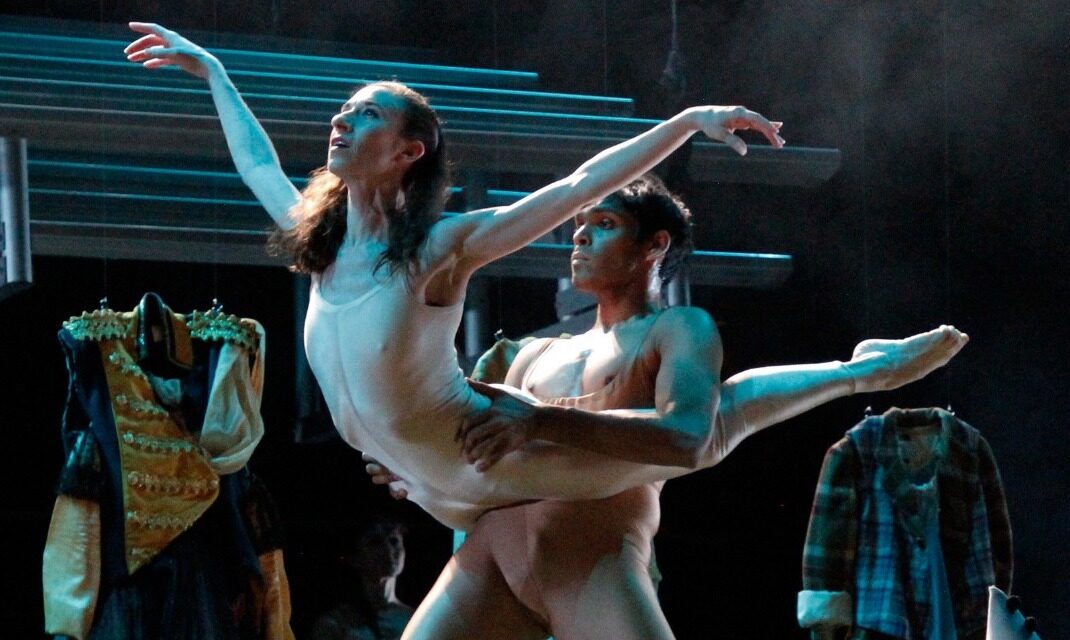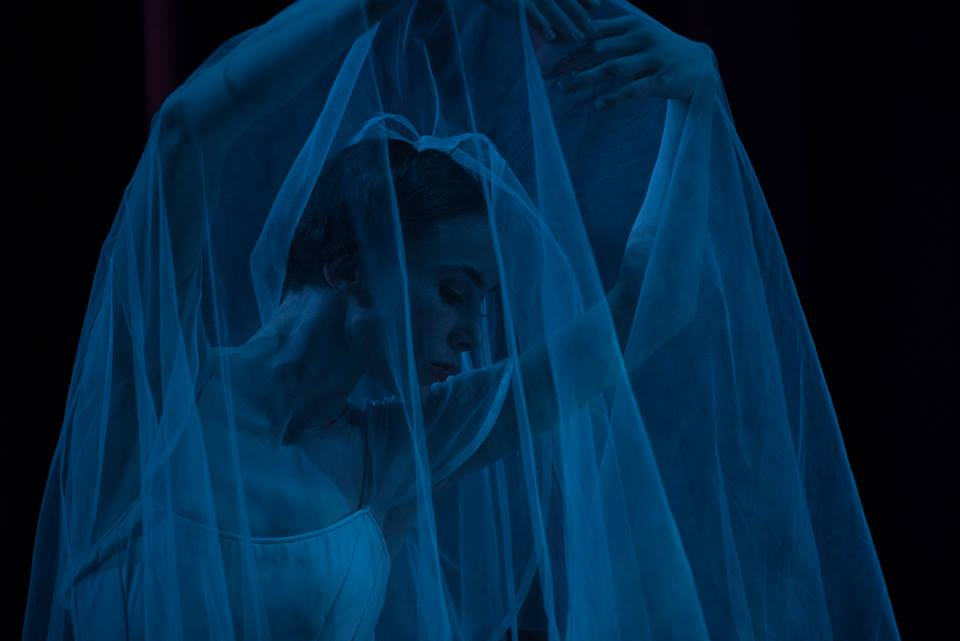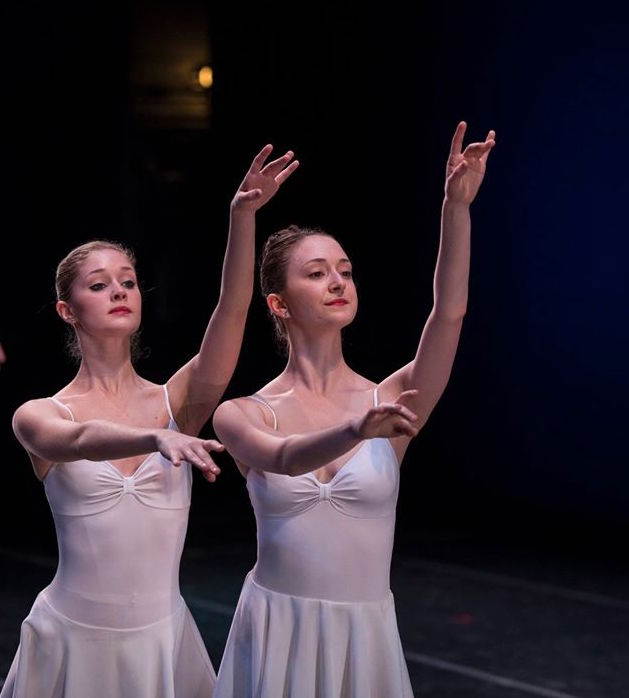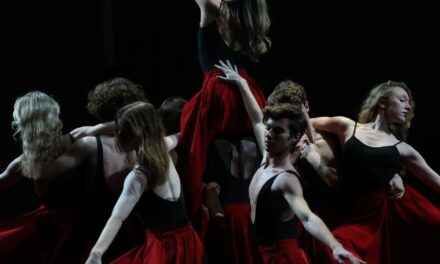Brienne Wiltsie & Sanjay Saverimuttu. Photo: Kateryna Sellers courtesy of Louisville Ballet.
Women In Focus
Choreography by Andrea Schermoly (Resident Choreographer), Ching Ching Wong, and the 2023 Dysart Award Winner Robyn Mineko Williams
A review by Amberly M. Simpson
Entire contents are copyright © 2023 by Amberly M. Simpson. All rights reserved.
The Louisville Ballet’s production of Women in Focus was visually stunning and well worth the watch.
The show opened with Limbic by resident choreographer Andrea Schermoly, which focused on the development of trauma response and our ability to heal.
This piece was both timely and reassuring as we, individually and as a human species, are learning to contend with our traumas, but what I enjoyed most was the emphasis on the relationship between the self and one’s inner child as a route to healing.
The moment where the soloist’s inner child carefully peeled away the clothing that had been thrown onto them was perhaps among the most beautiful moments in the choreography I have witnessed; it was a perfect moment of quiet after all of the chaos and angst of the first section of this piece. Additionally, the duets in unison against the vertically reflective stacked benches were not only a wonderful use of this prop but effectively supported the idea of trauma distorting our self-concept.
There were a few moments, particularly in section two of this piece before the duets merged into unison with each other, where it was unclear where my focus was intended to be directed. I felt as if I had to choose what to watch and that I was missing something important when I could not watch it all.
Given the title of the show, it is hard for gender to not become salient when watching the performances, but I was left wondering how important gender was to this piece, if at all. Given that the dancers started out in the same costume in spite of gender, and were likewise partnering with each other in non-gendered pairings in the first section of the dance, my initial instinct was that gender was irrelevant. However, when they started taking pieces of their clothing off, all of a sudden things became very gendered, which was confusing. Nothing about the topic of trauma is inherently gendered, and it is not framed as being about women’s trauma experience in the program notes, but then the choice to have what I perceived as the “trauma event” be represented by a male dancer aggressively stripping clothes off of a female dancer felt extremely gender-specific. It was gut-wrenching and visceral, and I commend the cast of this dance for their commitment to capturing something so painful. Nonetheless, it certainly was a shift from where we had started, and where the piece progressed to.
The second act consisted of 2023 Dysart Award winner Robyn Mineko Williams’s work Set. From the onset of the piece, I was immediately reminded of The Green Table by Kurt Jooss, but in a domestic setting.
The pacing of the piece seemed to reflect the passage of time as if you had hit fast forward on your VCR and were watching your entire life experience with this table as a time-lapse.
This was the only piece that seemed to explicitly connect to the experiences of women. The mother figure, played by Leigh Anne Albrechta, was who all other movement in the piece centered around, creating a sense of women/mothers being the heart of the household, and everyone else is tied together through her.
This piece suffered from the same problem as the first, but on a larger scale: there were several moments where you simply could not absorb everything that was going on in the space. However, this didn’t seem to prevent you from taking in the overall meaning, the sense of shifting relationships, the ebb and flow of conflict, and the solitude and reflectiveness of the mother figure that made it so poignant and relatable.
Leigh Anne Albrechta took on lead roles in both Limbic and Set and was absolutely flawless in both roles. She brought depth and range to both virtuoso and simple, gestural movements alike. From a costuming perspective, her role as a soloist or lead was not always obvious, but your eye was immediately drawn to her regardless.
Emmarose Atwood similarly shined in her duet with Albrechta in Set. Their relationship, which was meant to reflect that of a mother and daughter, felt both intimate and restrained all at once, as so often relationships become with the coming of age.
The show concluded with a spectacle-filled number by Ching Ching Wong entitled Grass is Green.
Visually, this work had many fascinating elements going for it. The use of the turf floor and bleachers in front of neon pink light strings, the eye-catching costumes, and, of course, the investment of the dancers were all strong elements that made it a good choice for the closing number of the show.
The piece immediately evoked a sense of being back in high school, staring out at the world and the rest of your life ahead, all possibilities (and all consequences) ahead of you. Albeit a bit gimmicky in its approach, this piece was successful in capturing, as Wong stated herself in the program notes, “our tenacity for wanting, the repercussions of having, and the beautiful heartache of hoping” through abstraction, symbolism, and impressionism.
In terms of movement vocabulary, the piece favored contemporary movement and partnering, but would occasionally break into more traditional petit allegro-style segments that felt like they didn’t quite belong with the rest of the movement.
Likewise, some of the more advanced nontraditional partnering, specifically in a trio performed by three men, felt perhaps too far out of the contemporary movement vocabulary and established partnering style. Nonetheless, it was nice to see ballet dancers venturing into this movement form, and I hope to see more such exploration in infuture with both more polish and more non-gendered and female participation!
As much as the quality of the choreographic and design work shines through with this show, I can’t help but have questions about the show’s theme, and whether Women in Focus was an appropriate title. Aside from the leadership and design positions being occupied by women (hooray!), and two out of the three numbers having female leads, I’m not sold on the idea that the show did as much to focus on women’s experiences, or even to highlight women, as much as it intended.
For example, two out of the three works in this show featured casts with the majority of male-presenting dancers: Limbic with 4 out of 7 dancers being male and Set with 5 out of 7 dancers being male*. Grass is Green came in slightly ahead with only five men alongside 13 women, but, as an ensemble piece, did not feature a female lead as the other two did.
Additionally, there was a surprising lack of diversity among the female cast of the show, especially when compared to that of the men. Who, then, ends up being in focus but a specific type of woman through which many audiences simply can’t see themselves in.
The subject matter of the pieces did not seem to inherently connect to women’s experiences. Both Schermoly’s Limbic and Williams’s Set had female leads, but I would argue that, had a male lead been cast, the concept would have been unchanged for both pieces. My questions around whether Limbic was specifically connected to women’s trauma vs trauma in general still remain, but Set, which seemed to more intentionally costume dancers around gender for its concept, examined women’s experiences in a domestic context. This is not necessarily problematic were it not the only piece that attempted to capture women’s experience specifically. Even if we assume that both pieces were intended to focus on women, does this potentially run the risk of pigeonholing women in antiquated stereotypes of being more emotional and as homemakers when there are no pieces to represent women alternatively?
The title of the show seemed to harken back more to its creative team, and less so to the content of the show itself.
Indeed, even in the preshow speech and the educational content provided on the show, there seemed to be an air of “this show is about women because we have historically vastly and disproportionately uplifted men into positions of power in the ballet world, but don’t worry, ballet is still for boys and men too!” I do understand the rationale and sensitivity of wanting to make ballet feel like boys and men can participate in a society that often discourages them from doing so, but the result was that, even in a show about women, the feelings of boys and men were placed at the forefront.
It’s worth noting that none of this addresses or creates space for more diverse gender representations, but that’s a rabbit hole the ballet world as a whole seems to simply not be ready to contend with. Though perhaps that is the inspiration for a future Spotlight Series!
None of this is to say that the show was not wonderful or worthwhile. But if we are, indeed, going to put women in focus, I think there is room for growth. I very much enjoyed witnessing the creative works that were brought forward in Women in Focus, and I very much look forward to future works of this caliber coming to the Louisville stage.
*I want to apologize if, in the process of writing this piece, I misgendered any dancers. My assumptions around gender were based on how dancers were costumed, as this was done through a binary lens.
Women In Focus
March 3 – 5, 2023
Louisville Ballet
Brown Theatre
315 West Broadway
Louisville, Kentucky 40202
Louisvilleballet.org
Amberly M. Simpson is a Choreographer, Dancer, and Dance Educator/Advocate originally from Glendale, California. She specializes in Modern, Post-Modern, and Contemporary Dance forms, creating work that is often interdisciplinary in nature to provide commentary on social issues and the human condition. By day, she is the Dance Director and Musical Theatre Co-Director at Noe Middle School, but by night she serves as the Artistic Director of Ambo Dance Theatre. Amberly’s work has been presented at venues such as the American Dance Festival Movies by Movers, the Going Dutch Festival, the Midwest Regional Alternative Dance Festival, and Princeton Research Day where her collaboration with Dr. David Vartanyan received the Impact Award. In 2019, she was honored as one of the Hadley Creatives through the Community Foundation of Louisville, and in 2022 she worked alongside her Dance colleagues in the Jefferson County Public Schools to launch the first ever All County Dance program for the state of Kentucky.





